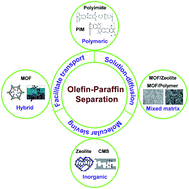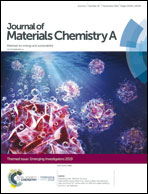Olefin/paraffin separation through membranes: from mechanisms to critical materials
Abstract
The separation of olefins and paraffin is one of the most challenging and energy-intensive processes, which has attracted increasing attention over the past decades. The well-established separation technology in industry, the so-called cryogenic high-pressure distillation, requires large distillation columns with 120 to 180 trays because of the similar sizes and boiling points of olefins and paraffin, which consumes a huge amount of energy. In addition to the traditional cryogenic distillation, non-thermal separation processes such as preferential adsorption and membrane separation have been developed to circumvent the utilization of heat and diminish the energy consumption. Membrane separation shows great advantages for olefin/paraffin separation due to their low energy consumption and continuous operation. Additionally, the rapid development of novel porous materials, e.g., metal organic frameworks (MOFs), covalent organic frameworks (COFs), and polymers of intrinsic microporosity (PIMs) has further boosted the research on the membrane separation of olefins and paraffin in recent years. In this review, we first summarized the separation mechanisms adopted to date for olefin/paraffin separation. Then, we summarized the materials used for the fabrication of membranes and separation, including traditional dense polymers, inorganic zeolites, carbon molecular sieves (CMSs) and newly developed MOFs. Special attention was paid to the new separation mechanisms, novel porous materials and strategies for membrane fabrication.

- This article is part of the themed collections: Recent Review Articles and Journal of Materials Chemistry A Emerging Investigators


 Please wait while we load your content...
Please wait while we load your content...